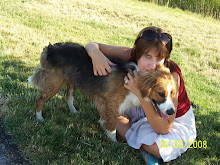
We have all been to someone's house who has one or more door chargers. There is nothing worse than being greeted by an overexcited dog who is pushing his head out the door to jump all over you. What comes next is an embarrassed, frustrated owner grabbing the dogs collar, shouting, and engaging in a tug-o-war with their dog. And, it never works.
Believe it or not, this annoying habit is one of the easiest to fix. First of all, the owner has to stop playing the game. That is what it is to your dog. He barks and charges, you pull and yell and eventually a new person comes in and gives lots of loving to the dog...what could be more fun?!
I went to a clients house once who wanted help with their small dog barking like crazy when the door bell rang. When I got their, I of course, had to ring the bell. What I heard on the other side of the door was "MOM! THE DOOR!" Followed by barking, running, feet, and then when the young girl in the house got to the door I heard her shouting (in a cute little girl voice) "NO, NO, NO, NO!" at the barking Bichon. I had to smile.
I told the owner that the problem wasn't her dog...It was her daughter! When the door rang her 7 year old was excited, running to greet who ever it might be, shouting at the top of her lungs. The dog was simply doing what the he thought the pack did when the doorbell rang. And when the little girl would shout NO over and over, he thought to himself "Yes, we all bark at the door"
I taught the family how to learn to freeze when the doorbell rang. Stop, take 3 deep breaths, then slowly walk to the door. Of course by this time their dog was already their barking, that's okay, I said. Just stand in front of the dog, back to the door, calmly make one sound (quiet, or eht, or whatever you want) Hold up your hand and wait for the dog to calm down. The door should never open until your dog is calm! Every time you open it when he is barking you are telling him "good boy, do it again next time"
Own the space around the door and do not allow them in it. My dog will indeed bark when the bell rings. I'm okay with this. She hears better than I and it has become her job to alert us when a guest is there...but, when I get to the door her job is done. I say "Place" and she goes about 5 feet away and sits next to the couch. I greet my guests and when they are in the door I will give Dolly a nod that she can calmly come to greet as well. A dog greeting should never include jumping, and if you wait to introduce until you pooch has calmed down they will be less likely to jump. In my home tail wagging and sniffing is the proper way to say hello. (you may have to remind young visitors of this rule, as children tend to want to get excited and start immediately playing with the dog).
After my visit with the barking Bichon, the dog had figured it out... it took a bit longer for the young girl to remember that calm is how we go to the door.
*Remember, teach everyone in the home not to get excited by the doorbell. Claim your space around the door and don't reward a barking dog by opening it when he's excited. If you need to, put a sign on the door that says, "Dog training, we will be with you shortly" Your guest will thank you, and your home will be much more peaceful.






